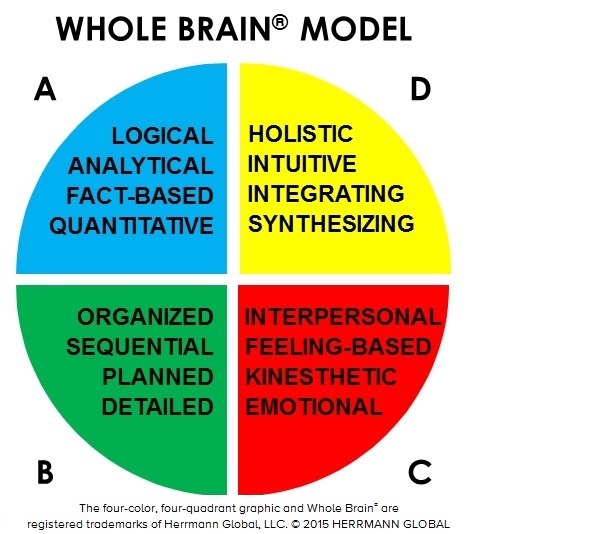
I was in the middle of a session with a group of private school headmasters who had gathered to talk about improving student performance. As I began to introduce the next activity, one that involved using a metaphor, one of the headmasters suddenly stood up.
“Excuse me, excuse me,” he declared to the group. “I don’t ‘do’ metaphors.”
I had already noticed this headmaster because I could tell he’d been distracted; his facial expressions and fidgeting were becoming harder to ignore. But now, his intolerance for this activity that he clearly disliked—metaphors—was so strong that, even before experiencing it, he felt it necessary to stop the program!
The Impact of Design and Delivery on Learning Outcomes
The first application of my study of the brain and the evolving theory of Whole Brain Thinking was in the domain of management education at GE’s Crotonville complex. The more I learned about the brain’s role in the learning process, the more curious and skeptical I became about the effectiveness of the programs I was involved with.
I decided to evaluate the programs and found that what participants learned covered a broad spectrum within a course, and less than half of that learning was what was actually intended. When I examined the participants’ learning preferences, I discovered a wide range, with several subgroups showing similar learning preferences. I then diagnosed the faculty members and discovered that they too had strong learning preferences.
Next, I examined the design of the courses and found that these were narrow in terms of the design methods used, and that they seemed to match the learning preferences of the course leaders. No wonder we were having problems! The course design and facilitators seemed to be in good alignment, but this was in good alignment with only part of the class. As many as half of the participants were so out of alignment with the course material and the facilitators that they were missing much of what they were intended to take back to their jobs.
My research has not only shown that any large organization taken as a whole represents a composite array of thinking preferences, equally distributed across the Whole Brain Model (see graphic below), but that the same is true for learning. In other words, there is a balanced distribution of learning preferences, with each quadrant and each mode being equally represented and seeking a particular learning approach.

More significantly, there is also an equal distribution of learning avoidances across the four quadrants. These avoidances cause people to tune out, just as the headmaster did. And a tuned-out learner is a waste of time, effort, money, and opportunity.
Training and development budgets range from thousands to millions or even billions of dollars annually. Much of this may be in vain because people are expected to participate and learn in programs that are out of alignment with their learning preferences, out of alignment with their job needs, and out of alignment with their career paths. The degree of match between the learner and the development content, the way the learner learns best, and the mode of delivery are all critical considerations for achieving desired learning outcomes. If we fail to take them into account, the learner’s engagement and attention can be affected, and he or she will fail to build the expected skills or competencies. At best, the outcomes will be temporary. My experience tells me that at least half of those attending in-house training programs are seriously out of alignment in one or more of these specific measures.
How Preferences Affect Learning
In the same way that we have built patterns of preference over the course of our lives as thinkers, each one of us as a learner has unique learning preferences. As a student, you probably did much better in some subjects and responded much more favorably to some teachers and teaching methods than others. Our research has shown that you probably retained some material more accurately and for a longer period of time than other material that was delivered in a different way.
Our learning preferences are the result of the brains we were born with, combined with the years of experience that have developed into our own distinctive learning approaches over the course of our lives. Once you understand how you prefer to learn, you can begin to take better control of your own growth and development. As a training professional, when you understand how other people think and learn, you can make faster connections and cut through the noise so you can focus on what really matters.
Thinking and learning preferences also can become the springboard for discussions with employees about how they can use their preferences more deliberately, and stretch to other quadrants beyond their preferences to meet specific competency requirements. For everyone, especially adults, learning takes energy, focus, and motivation. The way our society works today, there is a general avoidance of discomfort, with a strong desire to make things easier and more convenient. The discomfort created by the need to process new information or change the way you think is often a deterrent. Yet as my friend and HBDI® practitioner Manny Elkin, president and owner of Mindtech, Inc., once pointed out, “If you are not somewhat uncomfortable, then you are probably not learning!”
As for the headmaster who declared that he did not “do” metaphors? That comment affected the way I handled the metaphor activity. I explained the rationale and the process we would use, as well as the intended outcome, so that he would buy into it and participate—and he did.
In today’s world, learning isn’t a choice; it’s a necessity for keeping up with the relentless pace of change. Regardless of your thinking and learning preferences, all approaches across the Whole Brain Model are important and valid, which is why the most successful training professionals have the thinking agility to move beyond their comfort zones and filters. Remember: It’s your brain; for best results, use it daily!
Excerpt from “The Whole Brain Business Book,” Second Edition, by Ned Herrmann and Ann Herrmann-Nehdi (McGraw-Hill, 2015), adapted exclusively for Training. For more information, visit www.wholebrainbusinessbook.com.
Ann Herrmann-Nehdi is CEO of Herrmann International and a speaker, author, and thought leader on applying what we know about the brain to improve business performance.
Ned Herrmann pioneered the Whole Brain Thinking approach and is renowned for his bestselling books and research on thinking and its role in creativity, learning, and business.



